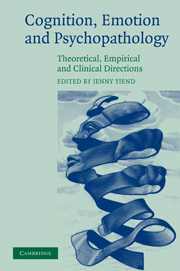Book contents
- Frontmatter
- Contents
- List of contributors
- An introduction and synthesis
- Andrew Mathews: a brief history of a clinical scientist
- Part I Theoretical approaches
- Part II Empirical directions
- Part III Clinical perspectives
- 10 Maintenance mechanisms in social anxiety: an integration of cognitive biases and emotional processing theory
- 11 Mental imagery and social phobia
- 12 Experimental cognitive psychology and clinical practice: autobiographical memory as a paradigm case
- 13 Mindfulness-based cognitive therapy
- 14 Clinical difficulties to revisit
- Index
11 - Mental imagery and social phobia
Published online by Cambridge University Press: 23 November 2009
- Frontmatter
- Contents
- List of contributors
- An introduction and synthesis
- Andrew Mathews: a brief history of a clinical scientist
- Part I Theoretical approaches
- Part II Empirical directions
- Part III Clinical perspectives
- 10 Maintenance mechanisms in social anxiety: an integration of cognitive biases and emotional processing theory
- 11 Mental imagery and social phobia
- 12 Experimental cognitive psychology and clinical practice: autobiographical memory as a paradigm case
- 13 Mindfulness-based cognitive therapy
- 14 Clinical difficulties to revisit
- Index
Summary
O wad some Pow'r the giftie gie us
To see oursels as ithers see us!
– Robert Burns, ‘To a Louse’When Robert Burns wrote this verse, he was observing how useful it would be for people to know how they come across to others. In a Festschrift to mark Andrew Mathews' distinguished career, we would like to reflect on how he comes across to his colleagues. Andrew Mathews is a visionary scientist who has made an enormous impact on the field. There are many reasons for the substantial impact his research programme has had over the years. First, Andrew Mathews and colleagues have been adept at devising novel paradigms that capture the essence of a clinical phenomenon while at the same time meeting all the rigorous requirements of experimental psychology. In this way, they have created paradigms and investigative approaches that have become classics in the field. Second, his attention to detail has allowed him to dissect phenomena in a way that enhances our understanding. A well-known example is isolating disengagement from stimuli (rather than lowered detection thresholds) as a key aspect of anxiety related attentional abnormalities (Yiend & Mathews, 2001). Third, while actively pursuing a theoretically driven approach, Andrew does not allow allegiance to one particular position to restrict his thinking and, as a consequence, can happily follow the data wherever they lead. Finally, his willingness to share his ideas and paradigms with others and his generous support of younger researchers has enriched the field and those who work within it.
Some of Andrew's recent research has focused on individuals who do not have an accurate understanding of how others see them.
- Type
- Chapter
- Information
- Cognition, Emotion and PsychopathologyTheoretical, Empirical and Clinical Directions, pp. 232 - 250Publisher: Cambridge University PressPrint publication year: 2004
- 1
- Cited by



